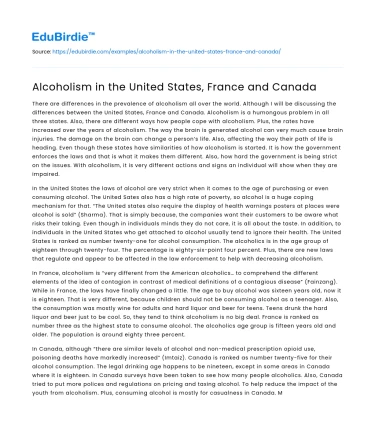There are differences in the prevalence of alcoholism all over the world. Although I will be discussing the differences between the United States, France and Canada. Alcoholism is a humongous problem in all three states. Also, there are different ways how people cope with alcoholism. Plus, the rates have increased over the years of alcoholism. The way the brain is generated alcohol can very much cause brain injuries. The damage on the brain can change a person’s life. Also, affecting the way their path of life is heading. Even though these states have similarities of how alcoholism is started. It is how the government enforces the laws and that is what it makes them different. Also, how hard the government is being strict on the issues. With alcoholism, it is very different actions and signs an individual will show when they are impaired.
In the United States the laws of alcohol are very strict when it comes to the age of purchasing or even consuming alcohol. The United Sates also has a high rate of poverty, so alcohol is a huge coping mechanism for that. “The United states also require the display of health warnings posters at places were alcohol is sold” (Sharma). That is simply because, the companies want their customers to be aware what risks their taking. Even though in individuals minds they do not care, it is all about the taste. In addition, to individuals in the United States who get attached to alcohol usually tend to ignore their health. The United States is ranked as number twenty-one for alcohol consumption. The alcoholics is in the age group of eighteen through twenty-four. The percentage is eighty-six-point four percent. Plus, there are new laws that regulate and appear to be affected in the law enforcement to help with decreasing alcoholism.
Save your time!
We can take care of your essay
- Proper editing and formatting
- Free revision, title page, and bibliography
- Flexible prices and money-back guarantee
In France, alcoholism is “very different from the American alcoholics… to comprehend the different elements of the idea of contagion in contrast of medical definitions of a contagious disease” (Fainzang). While in France, the laws have finally changed a little. The age to buy alcohol was sixteen years old, now it is eighteen. That is very different, because children should not be consuming alcohol as a teenager. Also, the consumption was mostly wine for adults and hard liquor and beer for teens. Teens drunk the hard liquor and beer just to be cool. So, they tend to think alcoholism is no big deal. France is ranked as number three as the highest state to consume alcohol. The alcoholics age group is fifteen years old and older. The population is around eighty three percent.
In Canada, although “there are similar levels of alcohol and non-medical prescription opioid use, poisoning deaths have markedly increased” (Imtaiz). Canada is ranked as number twenty-five for their alcohol consumption. The legal drinking age happens to be nineteen, except in some areas in Canada where it is eighteen. In Canada surveys have been taken to see how many people alcoholics. Also, Canada tried to put more polices and regulations on pricing and taxing alcohol. To help reduce the impact of the youth from alcoholism. Plus, consuming alcohol is mostly for casualness in Canada. Most people just drink for social reasons, to fit in and they get attached. Studies show that, Canadians drink a little bit more of the average limit of alcohol. The alcoholic age group is twelve years old and older. The percentage is approximately nineteen-point one percent. That is because the youth is exposed to the alcohol at such a young age. Also, they think that it is a good thing. Which it is not, because the younger they are the more addicted they get. Most teens get pressured into drinking and later become an alcoholic. The common difference in all three states are the thought of why individuals want their next drink ,
References
- Fainzang, Sylvie. “Alcoholism, a Contagious Disease. A Contribution towards an Anthropological Definition Of..” Culture, Medicine & Psychiatry, vol. 20, no. 4, Dec. 1996, p. 473. EBSCOhost, doi:10.1007/BF00117088.
- Imtiaz, Sameer, et al. “Substance Use and Population Life Expectancy in the USA: Interactions with Health Inequalities and Implications for Policy.” Drug & Alcohol Review, vol. 37, Apr. 2018, pp. S263–S267. EBSCOhost, doi:10.1111/dar.12616.
- Sharma, Manoj. “Role of Labeling in Prevention of Alcohol Abuse.” Journal of Alcohol & Drug Education, vol. 53, no. 3, Dec. 2009, pp. 3–6. EBSCOhost, search.ebscohost.com/login.aspx?direct=true&db=pbh&AN=48003268&site=ehost-live.






 Stuck on your essay?
Stuck on your essay?

